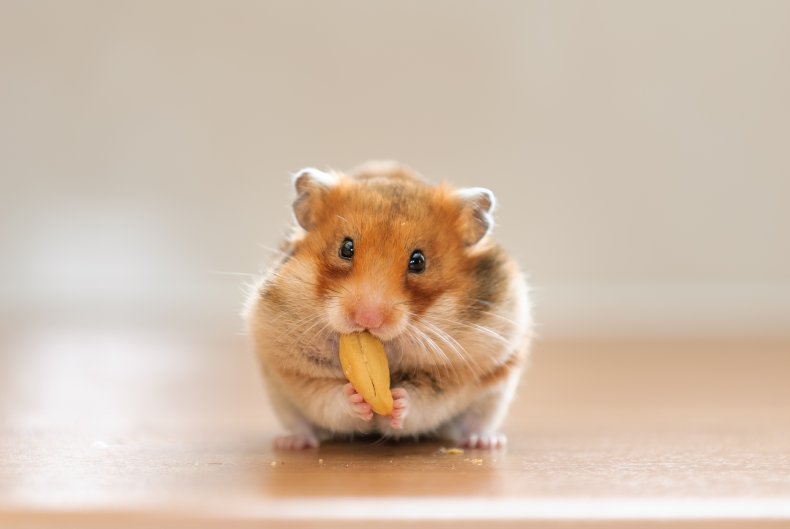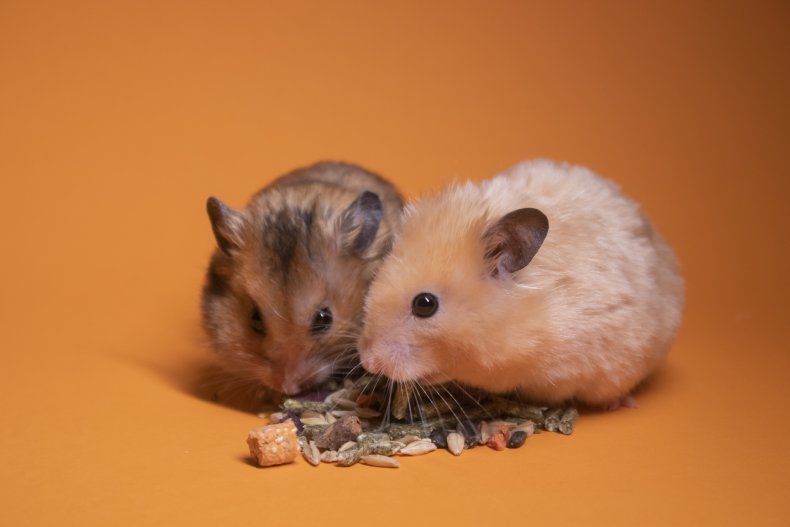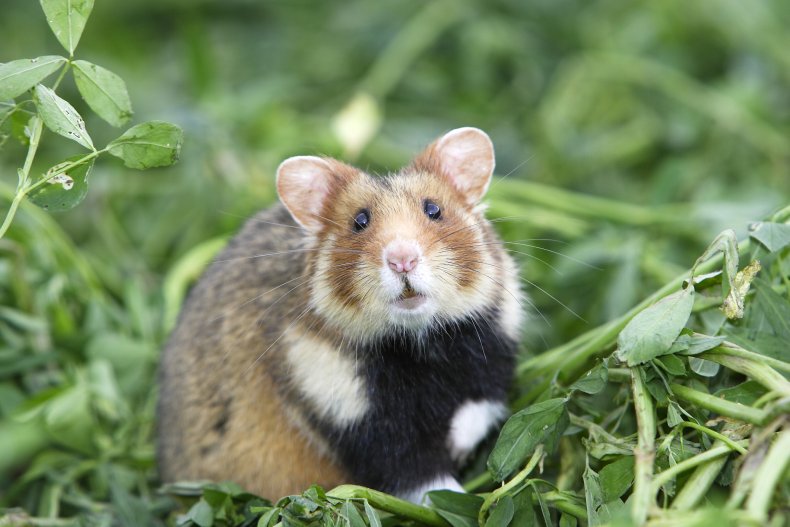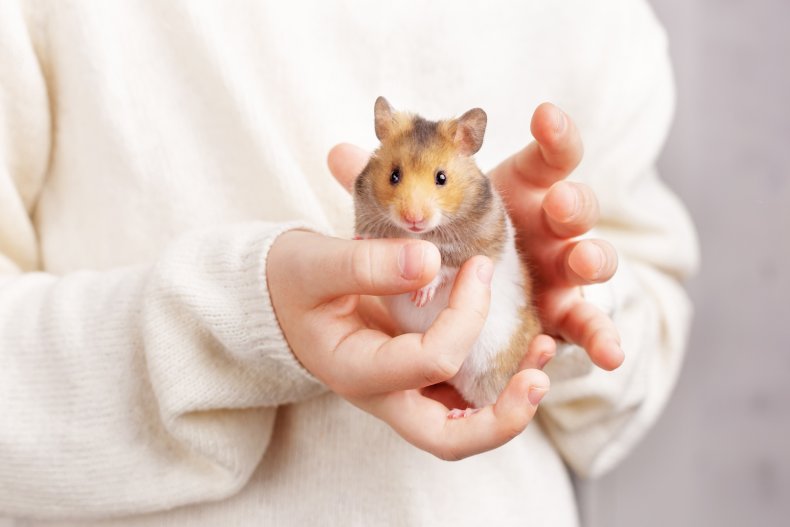Is It True That if You Touch a Hamster's Babies That Hamster Will Eat Their Own Babies
Hamsters make fantabulous pets, as they can become extremely attached to their humans.
These super-cute rodents may exist modest but their presence is always felt inside a household.
Withal, Gail Hansen, a veterinary representative of the Humane Society Veterinary Medical Association, said these pocket-sized animals still crave a loftier level of commitment.
She told Newsweek: "Hamsters are frequently considered a 'starter pet' because they are minor and beautiful, just they are nonetheless a large responsibility, so families who are thinking near getting a hamster should first carefully consider whether it is a good fit."
Read on to acquire some fascinating facts about the mutual hamster, as well known as the Cricetus cricetus.
i. Hamsters Take Been Known To Eat Their Offspring

People for the Ethical Handling of Animals (PETA) states hamsters do not eat their babies or each other "unless something is very, very incorrect."
The organization told Newsweek: "Cannibalism among hamsters is a sign of stress, normally because of astringent crowding, neglect, or inadequate care. We often see cannibalism in the pet trade, which packs hamsters together into crowded bins, where they are forced to compete for nutrient, water, and safe hiding spots.
Simon Hein, a conservationist at the High german Wildlife Foundation in Hamburg, stresses while it is very rare for hamsters in the wild to swallow their offspring, in that location are several triggers of this phenomena.
He said: "A lack of maternal experience—immature rodent females sometimes impale their kickoff litter, specially if they are relatively pocket-size and not fed a balanced diet.
"An unbalanced diet—in particular, a diet of corn leads to vitamin deficiency, which results in cannibalistic behavior.
"Overpopulation and intraspecies fights—when also many animals gather in besides small a space, information technology tin lead to attacks and cannibalism amidst themselves."
"Males might kill unrelated immature—mothers arrive rut afterwards that infanticide again and the infanticidal male will sire this female'south next offspring."
He added: "Especially the last betoken is not relevant for the open mural of Europe with the rare occurrences of hamsters. Cannibalism of the offspring is a relatively new area of research and hard to study in nature due to surreptitious burrows."
2. Hamster Species Are Critically Endangered
The mutual hamster is threatened with extinction in Europe due to habitat loss.
Simon Hein said: "Due to the loss of once-structurally rich agronomical areas and the expansion of industrial agronomics during the terminal decades, it increasingly lacks a suitable habitat.
"Few projects, like the projection Feldhamsterland of the German Wildlife Foundation, try to protect the last remaining occurrences of the common hamster.
3. There Are a Surprising Number Of Hamster Species

Dr. Jane Tyson, Imperial Society for the Prevention of Cruelty to Animals (RSPCA) rodent expert, states in that location are 24 species of hamster and they belong to the family Cricetidae.
She told Newsweek: "The Syrian, Russian, Dwarf, Campbell and Roborovski breeds are the most popular for pets."
iv. Hamsters Need Big, Secure Homes To Thrive
PETA told Newsweek: If an enclosure is too small, a hamster can develop 'muzzle rage', a condition caused by stress that can lead to bitter, excessive urinating, ceaseless cage-bar biting and other behavioral issues.
"Large hamsters should accept a minimum of 800 square inches of clear floor space, and dwarf hamsters should have at least 640.
"PETA recommends that hamster guardians build their own enclosures or use a 75-gallon (or larger) aquarium—that'south one over foiur feet long—with a fitted mesh chapeau."
5. Hamsters Are Surprisingly Large

Simon Hein notes how the modest rodents are "bigger than many call back."
He said: "A common hamster is more than twice as big as the famous golden hamster (Mesocricetus auratus) and tin grow up to 35 cm tall and counterbalance 650g.
"In order to be able to hoard supplies, for example in the form of grains, the rodent has big, expandable cheek pouches for transport.
"Depending on the size of the animal, these expandable 'hopping numberless' can hold well-nigh 60 grams of grains or other food. Translated to a human being scale, this would be like carrying 7 to eight kilograms of food in our cheeks."
six. Beware of Hamster Balls And Wheels
PETA suggests most marketed hamster wheels are too small, which tin can cause hamsters to arch their backs.
Information technology said: "These animals really need wheels with diameters of at to the lowest degree 11 inches (8 inches for a dwarf hamster), which may be marketed for rats.
"PETA doesn't recommend the use of hamster balls, which are extremely disorienting for these timid prey animals, who rely on their whiskers to navigate."
Dr. Tyson appeared to concur, adding: "Hamster balls may actually be stressful for hamsters as their sight is poor, they rely on other senses which could be restricted when confined to a ball.
"They could also find it very stressful when they collide with objects effectually the home and there is a potential take a chance of injury to the hamster's paws and/or legs if pinched or caught in the air holes in the practise ball."
7. Hamsters May Have a Hidden Defense Machinery

German Wild fauna Foundation good Simon Hein said: "I theory is that the special fur marking of the common hamsters serves as a defense confronting enemies.
"Thus, in case of inevitable danger, the defensible hamster stands on its hind legs and presents its blackness belly and the white insides of its legs.
"This may be to imitate a wide-open oral cavity of a large predator. By additional hissing and growling, he tries to drive away predators."
viii. A Solitary Hamster Can Exist a Happy Hamster
PETA said: "Syrian hamsters can bail with a man guardian but should not live with another hamster, as they are territorial.
"Dwarf hamsters tin live with a companion if introduced at a young enough age, but they might nevertheless fight. They yet need companionship, though—from their human guardians."
Dr. Tyson added: "Not all hamsters are sociable—in the wild, Syrian hamster adults generally live on their own in their burrows. Other species, such as the Russian dwarf, naturally alive in groups."
9. Hamsters Hide

To avert the lack of food and the cold in winter, the common hamster hibernates between Oct and April. Therefore, in addition to the summer burrow, it creates wintertime burrows peculiarly adapted to the cold flavour.
Hein said: "These are only used for hibernation and are deeper than the summer burrows (more one.2m deep). During hibernation, metabolic processes are reduced to an extreme minimum: Body temperature drops to ii to 3 degrees Celsius, breath rate to an boilerplate of one jiff per minute, middle rate to an average of five beats per minute, and brain action almost stops.
"In science, this state is called torpor, after the Latin term for 'solidification'. Such torpor phases in common hamsters can last from several days to a maximum of two weeks, but never the whole winter.
"Between the torpor phases, the rodent increases metabolism followed by an increase of body temperature. These events are called torpor bouts and used past hamsters to snack on its food storage, to visit the excrement chamber, and sleep.
"Indeed, true sleep during these torpor bouts are necessary to proceed the brain function alive. Hamsters, which are disturbed during their sleep events during hibernation, finish torpor with a fragmented retentiveness."
Dr. Tyson added: "Although they may seem cold and still, a hibernating hamster volition wake upwardly quite speedily in one case they warm up so if owners want to check if they are OK, they could effort moving them to a warmer part of the business firm.
"If an owner is unsure they should contact their vet for advice. Keeping them warm during the winter will help prevent pet hamsters from going into hibernation."
ten. Hamsters Party At Dawn And Dusk
PETA explained hamsters are crepuscular, significant that they spend daylight hours and dark burrowed in their nests.
The organization said: "Guardians should respect their sleeping schedules and not wake them up for playtime."
Dr. Tyson added: "Hamsters are nocturnal, with large eyes and a retina dominated by rods - the part of the eye that tin part in lower light."
Source: https://www.newsweek.com/why-hamsters-eat-own-babies-weird-facts-1655319
0 Response to "Is It True That if You Touch a Hamster's Babies That Hamster Will Eat Their Own Babies"
Post a Comment